Interviews
Swiss Made: Roger Federer
He is able to read his opponents movements with a seemingly supernatural ability – to predict their shots and then to react with mind-boggling creativity, finesse and precision. To watch him at the net is to feel as if he’s lived the entire shot sequence in a previous life and is simply repeating them through to the inevitable and effortless outcome of his victory.
He makes us laugh, not because of his sense of humour – which is vast – but because what he does on court so transcends the boundaries of normal ability, so completely redefines what a human being can do with a racquet and a ball, that often even his opponents are left marvelling at the artistry and the sheer poetry of his game. And after each tournament he steps away with unabashed nonchalance, sometimes accompanied by a wry smile or a little laugh, but always Mr Cool.
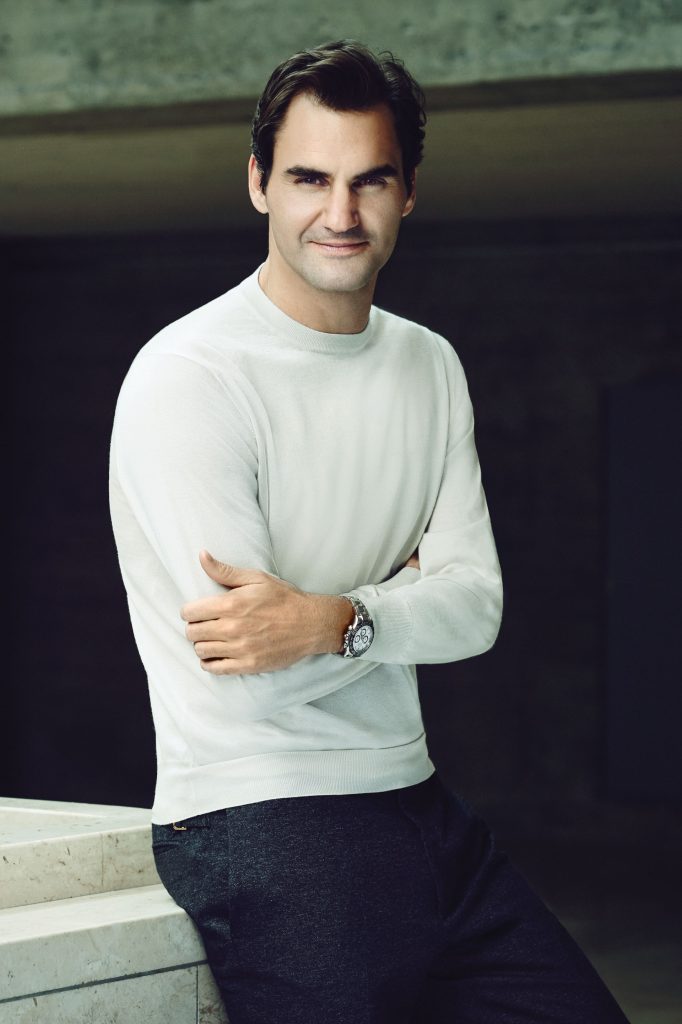
Rolex Testimonee, Roger Federer wears the 2016 steel Daytona with monobloc Cerachrom bezel (image © Rolex/Chris Storrar)
The Big Chill
Lack of pressure is something that shines through for anyone who has seen Federer on the court. And for him it is essential to have what he refers to as “mental freedom” in order to not feel trapped by routine, superstition or pressure and to empower his creativity on court. “In the end it is a game that we are playing and you have to be creative while you are playing it,” he emphasises. “It’s not a matter of just putting your head down and powering through.
“It’s neither a sprint nor a marathon. We have a ball involved and it is by nature a playful game, a game that rewards creativity. And you want to be really inspired by this aspect of tennis. Sometimes when you are too tightly wrapped, too much in a shell, you can’t see clearly any more. That’s when you take incorrect decisions and that can be the difference between winning and losing.
“That’s why I feel that this balance between being playful and free and being super-serious and professional is extremely important. It allows you to recognise and make the right play at the right time and this is perhaps the crucial thing you need to have as a tennis player. But then again, of course, I believe in old school preparation. You do the drills time and time and time again. It might be a bit boring or monotonous but I do believe it’s going to help you to know you have that base when you come onto the court. If you need to put the drills in place you can, otherwise you can use your creativity to win – especially with my game.”
Nowhere has Federer’s creativity been better demonstrated than with the magnificent “tweener” (between-the-legs shot) executed in the semi-finals of the US Open in 2009 to take Novak Djokovic to triple match point. “Obviously you make up a shot like that because you don’t have many other choices,” laughs Federer at the memory. “Novak was in perfect position at the net. I could have hit a lob, but I felt that I would lose the point. I know from practice that I can hit the between-the-legs shot pretty well. I thought I’d probably lose the point but we were on Centre Court at the US Open. I thought I might as well try and see what happened.
“All of this went through my mind super fast, and then before I knew it I just reacted. All of a sudden I turned around and I saw the ball was already past Djokovic and it was already a winner and I was suddenly at triple match point. It’s at that point you think to yourself: ‘Oh my God!’ You’re suddenly uplifted and you feel the level of your game rise. So next point on his second serve I ran around it and hit a cross-hand winner to take the match. Those were two unbelievable shots within a minute. You don’t know in the moment what’s going on, but later you realise that this was a really special shot. Who knows if I’ll ever hit another like it in the rest of my career. It was very rare, it happened in the moment and the crowd loved it and it goes down for me as one of the greatest shots I was ever able to hit.”
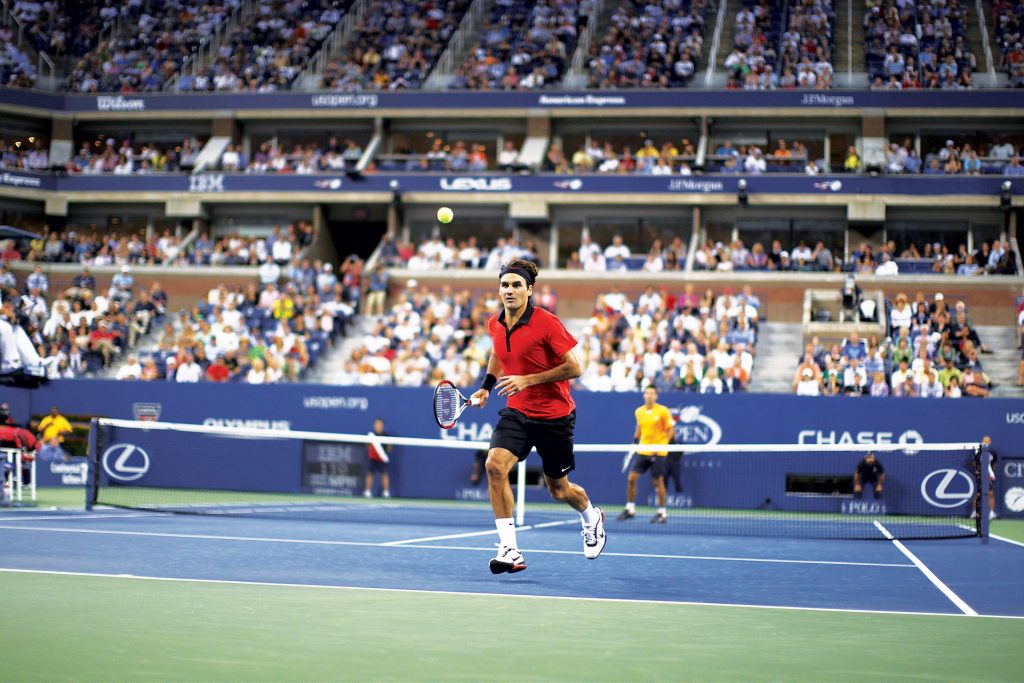
Federer demonstrates his legendary “tweener” shot against Novak Djokovic in the semi finals of the 2009 US Open (Image © Getty Images)
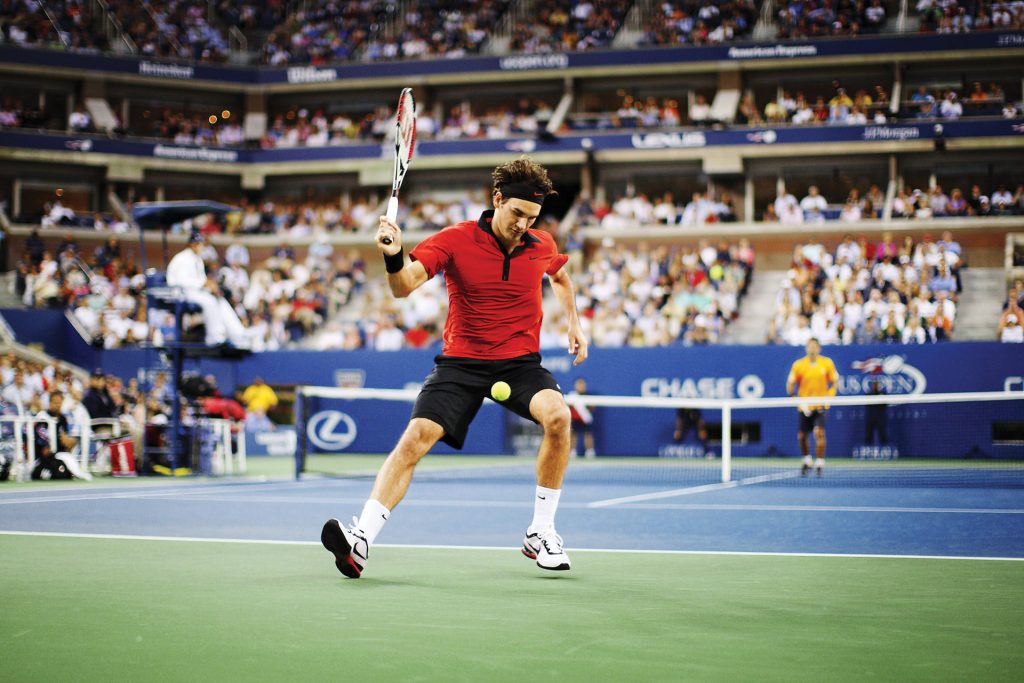
Federer demonstrates his legendary “tweener” shot against Novak Djokovic in the semi finals of the 2009 US Open (Image © Getty Images)
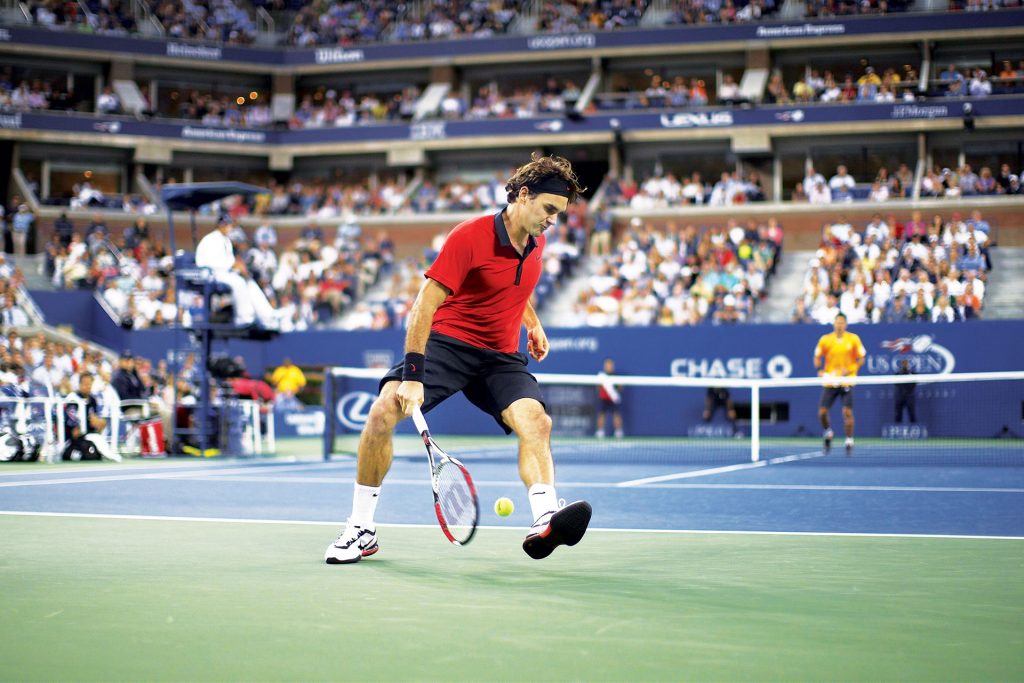
Federer demonstrates his legendary “tweener” shot against Novak Djokovic in the semi finals of the 2009 US Open (Image © Getty Images)
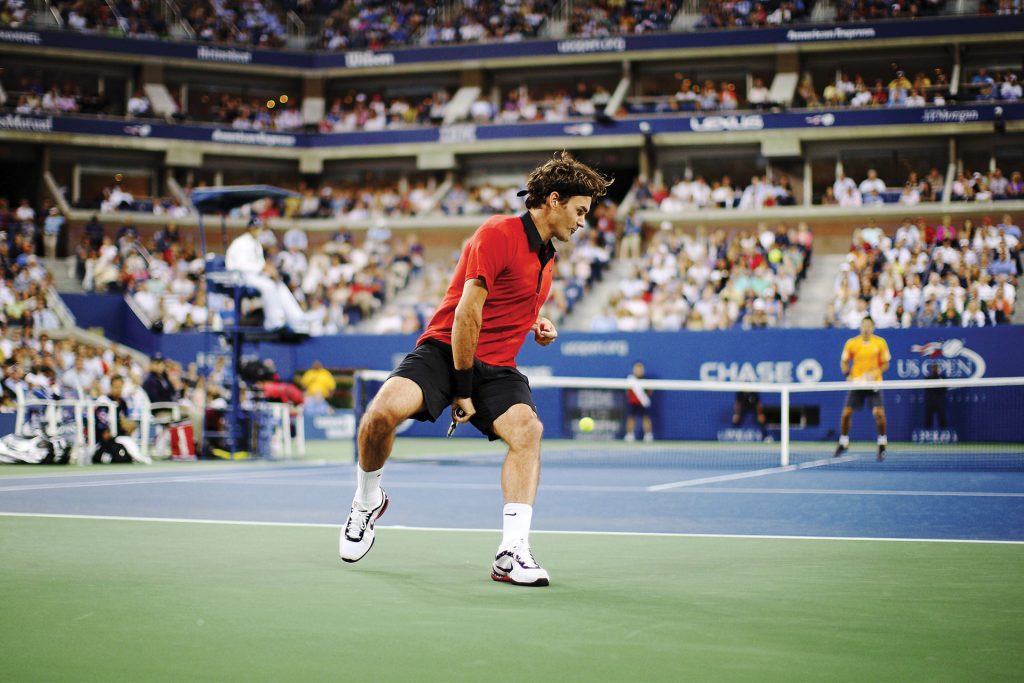
Federer demonstrates his legendary “tweener” shot against Novak Djokovic in the semi finals of the 2009 US Open (Image © Getty Images)
Eye On The Ball
Looking back on his early days of playing, Federer describes himself as “a racquet-throwing brat”, something that he made a conscious decision to move away from when he realised this emotionality was preventing him from realising his full potential. “There are so many ways you can address this challenge,” he recalls. “One way is to have a mental trainer as I did. For years he tried to calm me down. He talked to me all the time about how not to lose my temper. I also had numerous conversations with my parents, with my friends, with my coaches, with everybody really. Every single person told me the same thing, which was that it would never be beneficial to my game if I kept self-destructing.”

Federer in the semi final of the Monte-Carlo Rolex Masters in 2015 (Image © Rolex/Gianni Ciaccia)
“I saw that it was working, but it was maybe too effective and the fire started to leave me a little bit. I realised that I was being slightly too quiet. My reaction to my best shots would be sort of normal. And after my worst shots I would be like ‘whatever’. And I didn’t like this feeling. It took six months to a year to finally get the fire back but I retained this sense of calmness. And all of a sudden something clicked and that’s when the results really began to come. In 2003, I still had some up and down results. I lost the first round in the French Open but then I won Wimbledon. And, once I won Wimbledon, I knew. I knew that I could achieve the highest level in tennis so I just had to try to achieve this as often as possible. At the same time I had to bring my worst level of tennis up and then I could have a great career. And I’ve stayed in the Top 10 ever since that moment.”
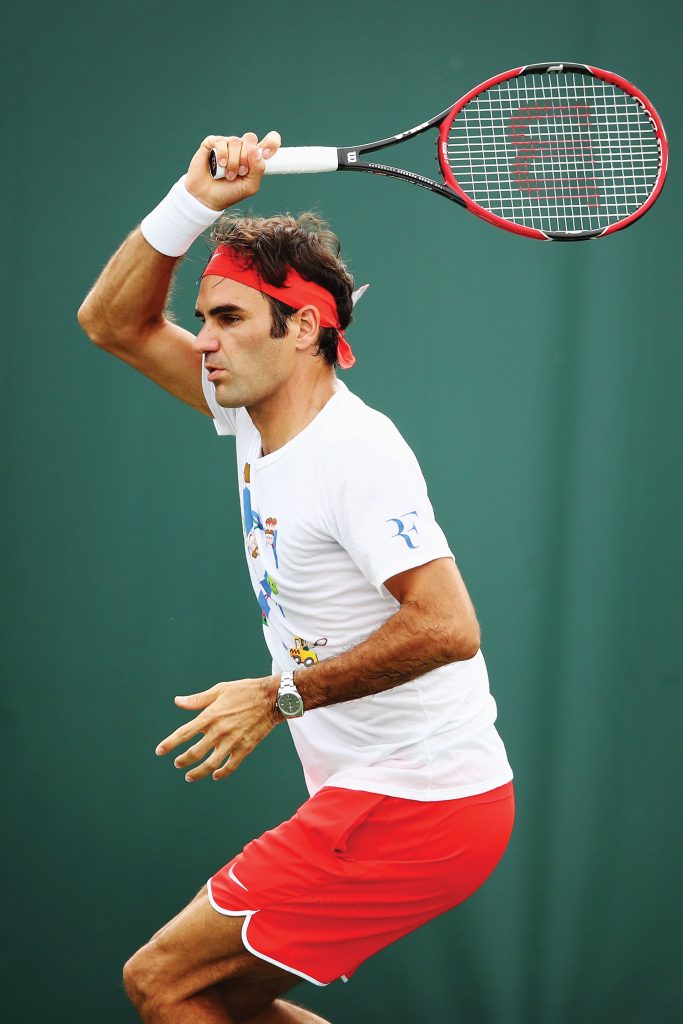
Image @ Getty Images
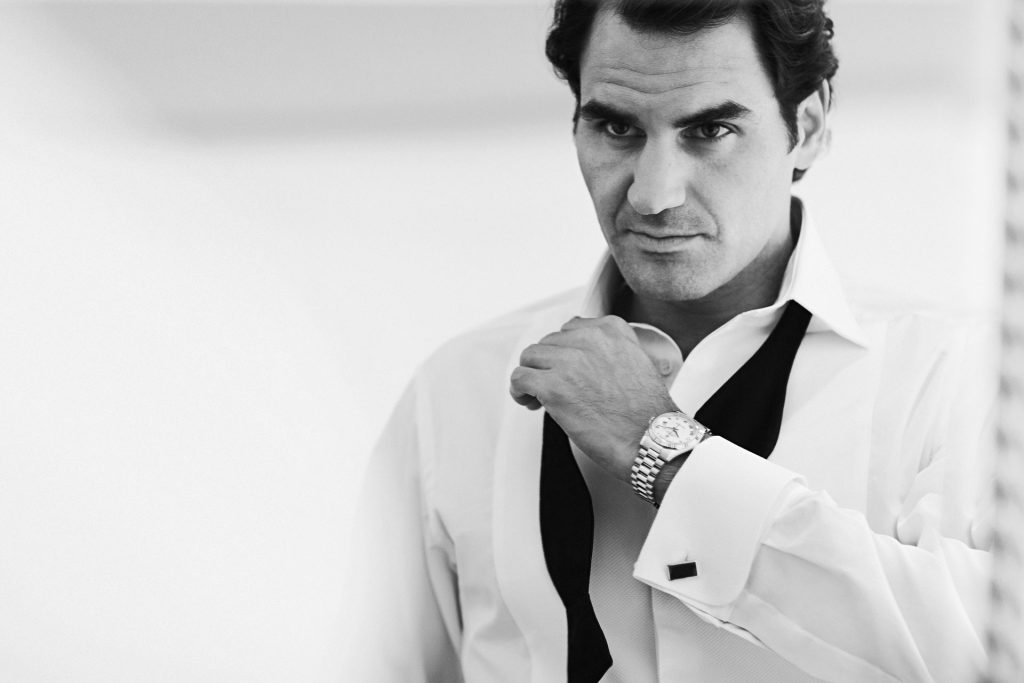
Federer, wearing an Oyster Perpetual Day-Date (Image © Rolex/Chris Storrar)
Playing to Win
Over the years and the 17 Major singles titles – the most ever by any man in history – there have been many standout moments for Federer, not least of which was winning his seventh Wimbledon championship in 2012, nine years after winning his first. “By then I had family, and winning for the seventh time is always going to feel different than winning for the first time,” he reminisces. “But the victory in 2012 was very significant for me because I regained my World Number One ranking – not immediately but I think a week later. It was just an unbelievable win because I played great throughout. It was tough because the Olympics came on the back of Wimbledon and I made it to the finals, losing to Andy Murray. That summer was magic.
“However I have to say Wimbledon 2003 is still the most important win of my career. Just getting to that point and feeling like all the work I’d put in had brought me to that place where I’d achieved the ultimate win in my favourite tournament and that my career was really on the right track. It was such a special victory as you can see from my reaction.”
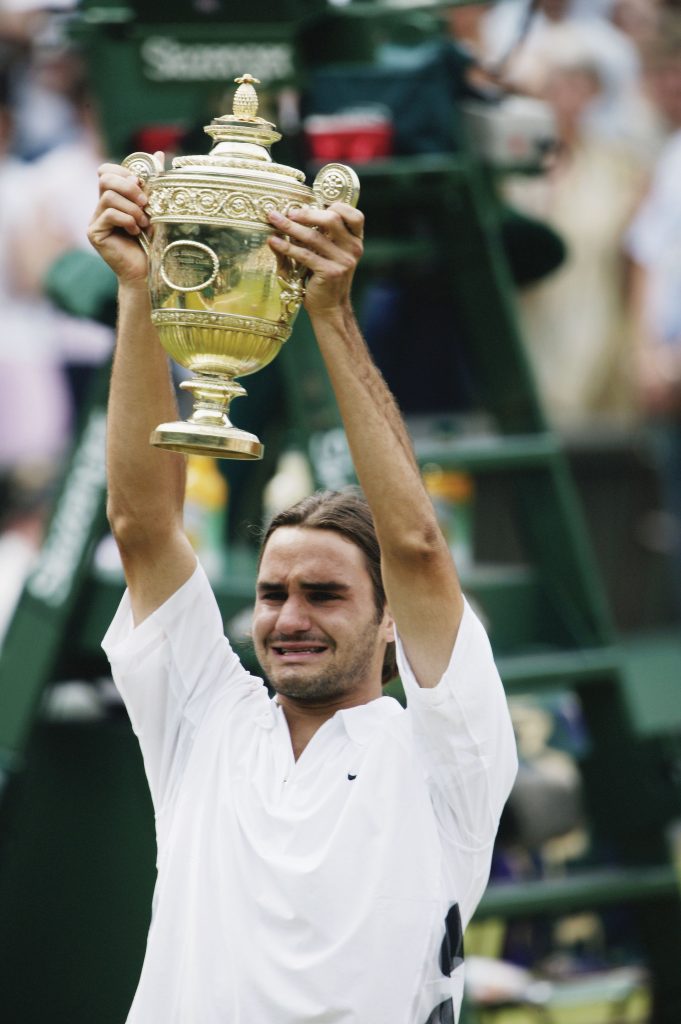
Winning Wimbledon in 2003 (Image © Getty Images)
“Juan Martín del Potro was an epic five-set battle, I thought it was a really tough quarters that I had there. Rafa had lost early so then all the pressure shifted to me. Basically what was going through my head was: ‘If you don’t win this year, you are never going to win’. So I was playing under that kind of scrutiny and the final against Robin Söderling was a must-win. It was in the drizzling rain and it is one of my favourite victories. I look back at the video and I get goose bumps because it was such an epic moment. I had 80 friends there from Switzerland. All my best friends were there. It was an incredible ovation and the Parisian crowd was simply amazing.”
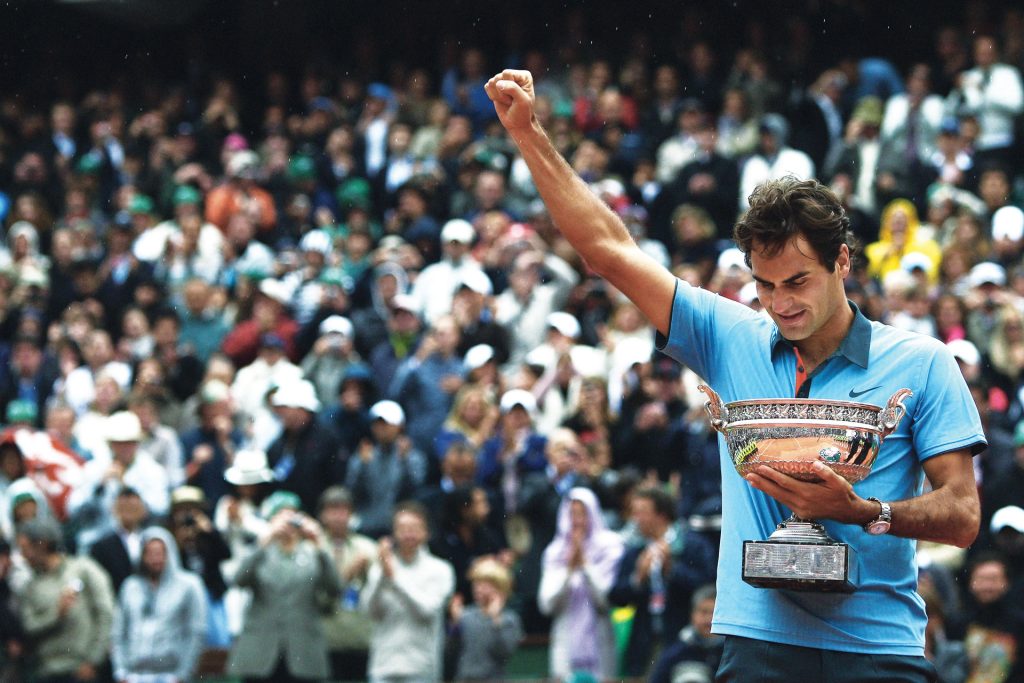
Federer wins the elusive French Open in 2009 (Image © Getty Images)
“The way we won it was so memorable. We had two games in Switzerland – the quarters and the semis. 14,000 people were at the first, then 18,000 at the second, which were record numbers in Geneva for a tennis match. Then going away to Lille to try to win it. I remember I had this back problem the week earlier from the world tour finals. I really wasn’t sure if I was going to be able to play or not. But in the end we were all able to play – the whole team.
“It was an unbelievable story because all of us are best friends, we weren’t just tossed together with the mission to win the Davis Cup, we’ve known each other for more than 20 years and we grew up in the game together. It was so amazing for us to do it together. We had amazing crowd support and we got such an amazing reception when we got back home. There were 10,000 people in Lausanne where I went to school and where Stan [Wawrinka] grew up. I couldn’t have been happier.
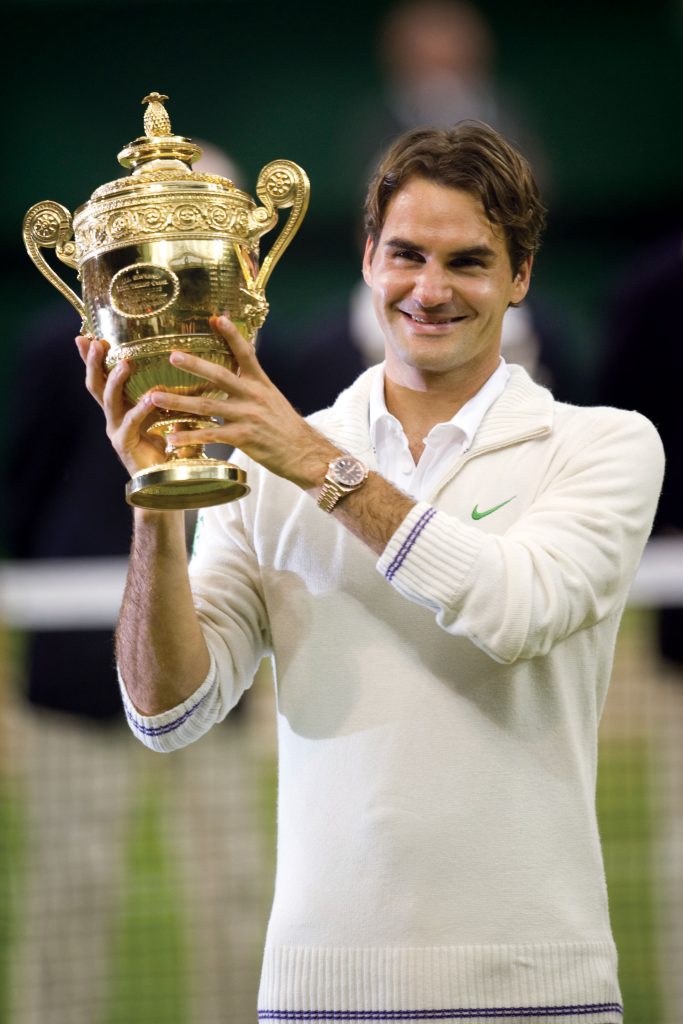
Federer lifts the Wimbledon trophy in 2012 (Image © AELTC Jon Buckle)
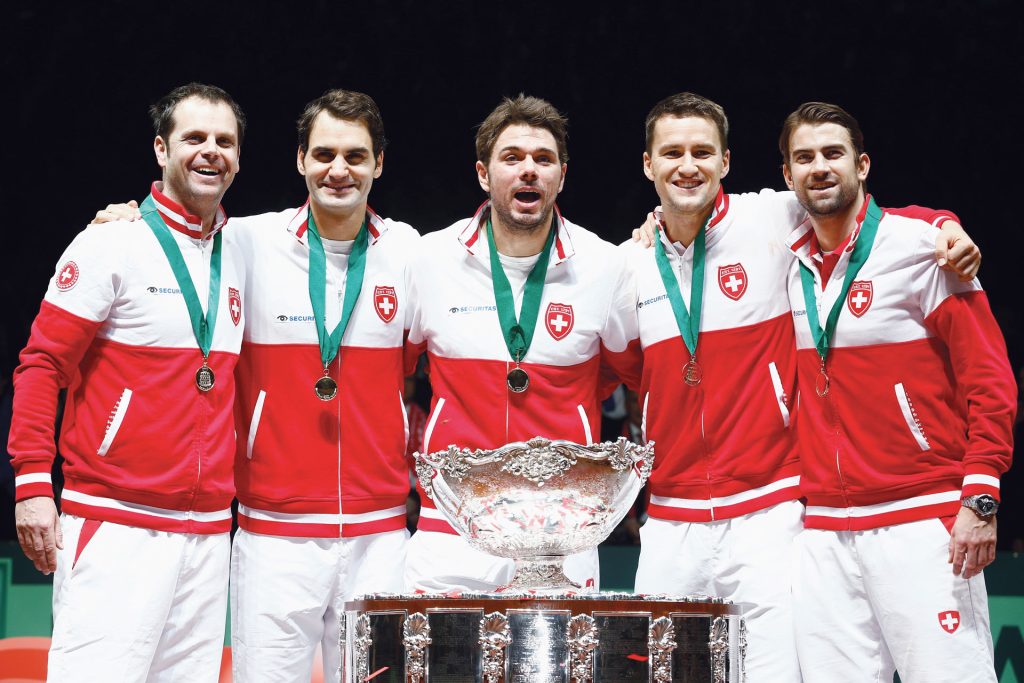
The victorious 2014 Swiss Davis Cup team (Image © Getty Images)
Family Guy
Federer is the first to admit that the support of his wife, Mirka – herself a former professional tennis player – is a major contributing factor to his continued success.And he acknowledges that her personal sporting experiences certainly help in understanding the demands of the circuit. “It’s definitely helpful in the sense that she knows what it takes to be competitive at the top end of the game,” he says.
“She was an unbelievably hard worker – not that I wasn’t, but she was definitely much harder working when she was young than I was. I was the guy that was asking after an hour: ‘Can we do something different now? Can we play football?’ Whereas she would do six hours of practice straight, I couldn’t do that when I was younger. So she helped me to get the mindset that you have to put in the long hours. You have to grind it out. It’s just what it is. When we started dating, I didn’t have any titles and today I have 88. So she’s been a huge part of my life and a huge part of my career. And she’s helped me grow not just as a tennis player but also as a person. She’s been there every step of the way. She’s my wife, she’s the mother of my children and I couldn’t be happier right now.”
And when Federer refers to his children, he is talking about two sets of twins, six-year-old girls Myla and Charlene, and boys Leo and Lenny, who are almost two. “It’s busy, but it’s been really nice,” he says of his family life. “When I was doing the rehab for my knee earlier this year I got to spend a lot of time with them. Looking back at the past six years, it’s a lot of work having children but it’s also the most rewarding thing. As a family, we have the best time and the kids love each other, which is so important. It’s interesting because the girls are identical twins and they share something very special, something that normal people who only have a brother or a sister might not understand. I don’t have a lot of perspective on this but hopefully one day when they are older they can fill me in.”
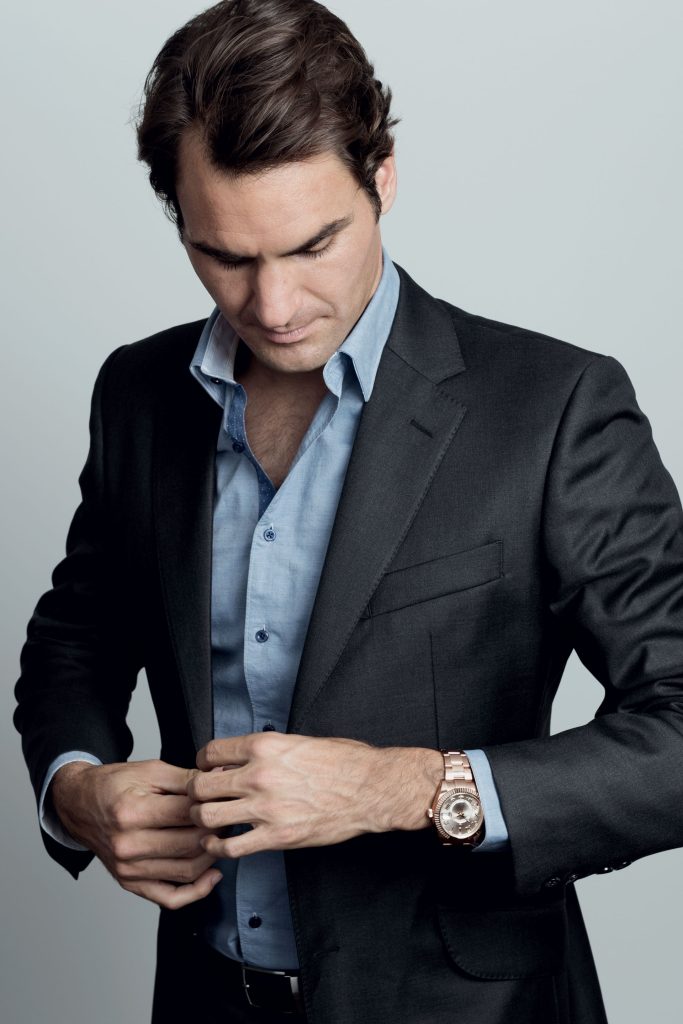
Federer, wearing an Oyster Perpetual Sky-Dweller (Image © ROLEX/Sophie Ebrard)
Watching The Game
The game of tennis has brought Federer a great deal – a career, a family and an introduction to one of the biggest brands on the planet: Rolex. Despite growing up in Switzerland, the company meant little to him as a child, his first awareness of Rolex coming through tennis. “They are such a big part the sport – especially at Wimbledon, which is my favourite tournament,” he says. “I remember becoming familiar with the name around the time I was watching Stefan Edberg and Boris Becker playing at Wimbledon.”
Now an established Rolex Testimonee, Federer’s knowledge of, and respect for, the brand have both grown enormously. “Like everyone else, I think of Rolex as an unbelievable watch brand. It’s the watch you want to have if you’ve worked hard in your job and want to give yourself a nice present. There are wonderful people working at the brand. I’ve met so many people from the top down and they are all super friendly.
“One quality that you don’t see so often today is loyalty and I love the loyalty that people at Rolex have for their brand. Then I love the designs of the watches – they are absolutely timeless. I like the detail and the craft that goes into the Swiss watch industry in general, but Rolex is clearly my favourite. And the watch that I’m wearing [on the cover of this issue of Revolution], the steel Daytona with the ceramic bezel, is really special.
“For me, every time I put on a new Rolex I feel that I’m happy I have two boys because we will be able to share these watches one day. That’s not to say they will get them too early, but I admit that every watch I wear today, I hope my boys will get to wear in the future. I like to think of them as the family’s collection of Rolexes.”
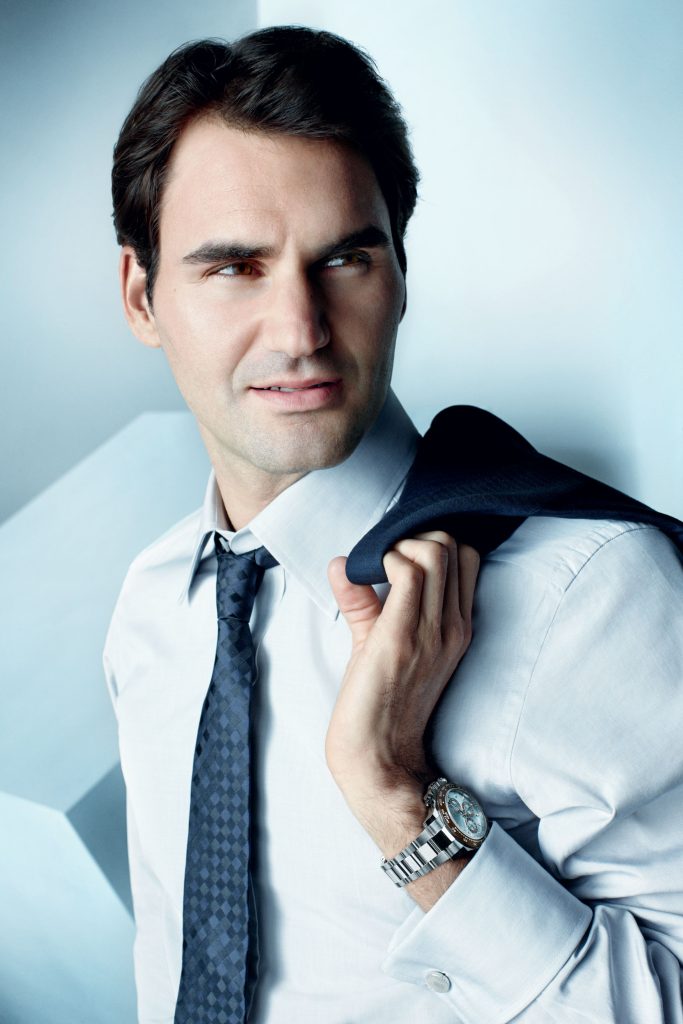
Federer, wearing an Oyster Perpetual Cosmograph Daytona (Image ©Rolex/Adam Whitehead)










